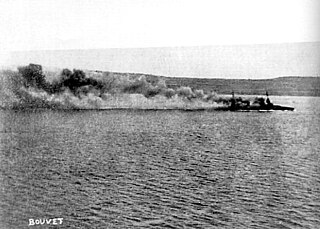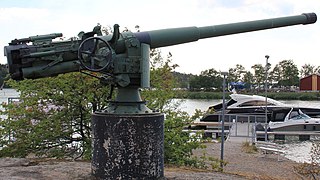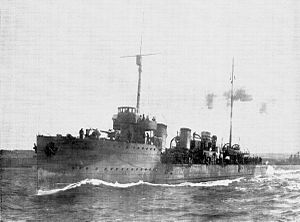
The naval operations in the Dardanelles campaign took place against the Ottoman Empire during the First World War. Ships of the Royal Navy, French Marine nationale, Imperial Russian Navy and the Royal Australian Navy, attempted to force a passage through the Dardanelles Straits, a narrow, 41-mile-long (66 km) waterway connecting the Mediterranean Sea with the Sea of Marmara and the Black Sea further north.

SMS Breslau was a Magdeburg-class cruiser of the Imperial German Navy, built in the early 1910s and named after the Lower Silesian city of Breslau. Following her commissioning, Breslau and the battlecruiser Goeben were assigned to the Mittelmeerdivision in response to the Balkan Wars. After evading British warships in the Mediterranean to reach Constantinople, Breslau and Goeben were transferred to the Ottoman Empire in August 1914, to entice the Ottomans to join the Central Powers in World War I. The two ships, along with several other Ottoman vessels, raided Russian ports in October 1914, prompting a Russian declaration of war. The ships were renamed Midilli and Yavûz Sultân Selîm, respectively, and saw extensive service with the Ottoman fleet, primarily in the Black Sea against the Russian Black Sea Fleet.

Naval warfare in World War I was mainly characterized by blockade. The Allied Powers, with their larger fleets and surrounding position, largely succeeded in their blockade of Germany and the other Central Powers, whilst the efforts of the Central Powers to break that blockade, or to establish an effective counter blockade with submarines and commerce raiders, were eventually unsuccessful. Major fleet actions were extremely rare and proved less decisive.

Asian and Pacific theatre of World War I consisted of various military engagements that took place on the Asian continent and on Pacific islands. They include naval battles, the Allied conquest of German colonial possessions in the Pacific Ocean and China, and an anti-Russian rebellion in Russian Turkestan and an Ottoman-supported rebellion in British Malaya. The most significant military action was the careful and well-executed Siege of Tsingtao in China, but smaller actions were also fought at Bita Paka and Toma in German New Guinea.

Naval warfare in the Mediterranean during World War I took place between the naval forces of the Entente and the Central Powers in the Mediterranean Sea between 1914 and 1918.

Novík was a destroyer of the Russian Imperial Navy and Soviet Navy, commissioned in 1913 where she served with the Baltic Fleet during World War I. She joined the Bolsheviks in November 1917 and was renamed Yakov Sverdlov in 1923. She was a training ship when Operation Barbarossa began, but was recalled to active duty the following day. She struck a mine on 28 August 1941 and sank while escorting an evacuation convoy during the Soviet evacuation of Tallinn.
A naval race had developed in the Aegean after the end of the Balkan Wars, with the Ottoman government ordering several ships, including two dreadnoughts, in Britain. In the event, with the outbreak of World War I, one of these ships, including further two scout cruisers and four destroyers, were confiscated and pressed into service with the Royal Navy. This disappointed the Ottomans, contributing to their joining the Central Powers in the Great War.

The Derzky or Bespokoiny-class destroyers was a class of destroyers built for the Imperial Russian Navy just before World War I. Nine ships were built for the Black Sea Fleet. These ships were a derivative of the Russian destroyer Novik, but were slightly smaller. These ships were popular with the Russians and effective particularly in the Black Sea, where the Ottoman Navy had no similar ships.

The Battle of the Gulf of Riga was a World War I naval operation of the German High Seas Fleet against the Russian Baltic Fleet in the Gulf of Riga in the Baltic Sea in August 1915. The operation's objective was to destroy the Russian naval forces in the Gulf in preparation for landing German troops to facilitate the fall of Riga in the later stages of the Central Powers' offensive on the Eastern Front in 1915. The German fleet, however, failed to achieve its objective and was forced to return to its bases; Riga remained in Russian hands until it fell to the German Army on 1 September 1917.

The QF 3-pounder Hotchkiss or in French use Canon Hotchkiss à tir rapide de 47 mm were a family of long-lived light 47 mm naval guns introduced in 1886 to defend against new, small and fast vessels such as torpedo boats and later submarines. There were many variants produced, often under license which ranged in length from 32 to 50 calibers but 40 caliber was the most common version. They were widely used by the navies of a number of nations and often used by both sides in a conflict. They were also used ashore as coastal defense guns and later as an anti-aircraft gun, whether on improvised or specialized HA/LA mounts.

Berk-i Satvet was a torpedo cruiser of the Ottoman Navy, the second and final member of the Peyk-i Şevket class. She was built by the Germaniawerft shipyard in Germany in 1906–07, and was delivered to the Ottoman Navy in November 1907. The ship's primary armament consisted of three 450 mm (18 in) torpedo tubes and a pair of 105 mm (4.1 in) guns, and she was capable of a top speed of 21 knots. The ship's early career was uneventful; the Italo-Turkish War of 1911–12 passed without any action of the Ottoman fleet. Berk-i Satvet saw action during the Balkan Wars of 1912–13 in the Aegean and Black Seas, against Greek and Bulgarian opponents, respectively.

A torpedo cruiser is a type of warship that is armed primarily with torpedoes. The major navies began building torpedo cruisers shortly after the invention of the locomotive Whitehead torpedo in the 1860s. The development of the torpedo gave rise to the Jeune École doctrine, which held that small warships armed with torpedoes could effectively and cheaply defeat much larger battleships. Torpedo cruisers fell out of favor in most of the great power navies in the 1890s, though many other navies continued to acquire them into the early 1900s.

Eugeniusz Józef Stanisław Pławski was a Polish Navy officer who served in World War I and World War II. He was the commander of the ORP Piorun (G65) during the hunt for Bismarck.

The 102 mm 60 caliber Pattern 1911 was a Russian naval gun developed in the years before World War I that armed a variety of warships of the Imperial Russian Navy during World War I. Pattern 1911 guns found a second life on river gunboats and armored trains during the Russian Civil War and as coastal artillery during World War II. In 1941 it was estimated that 146 guns were in service. Of these, 49 were in the Baltic Fleet, 30 in the Black Sea Fleet, 30 in the Pacific Fleet, 18 in the Northern Fleet, 9 in the Caspian Flotilla and 6 in the Pinsk Flotilla.

Shaumyan (Шаумян) was one of eight Fidonisy-class destroyers built for the Imperial Russian Navy during World War I. She was originally named Levkas (Левкас) before she was renamed Shaumyan in 1925. Left unfinished during the Russian Revolution in 1917 and later captured by Ukrainian and White forces, the destroyer was completed by the Soviets in 1925 following their victory in the Russian Civil War.

Steregushchy was one of 29 Gnevny-class destroyers built for the Soviet Navy during the late 1930s. Completed in 1939, she was assigned to the Baltic Fleet. The ship played a minor role in the Winter War of 1939–1940 against the Finns. After the start of the German invasion of the Soviet Union in June 1941, Steregushchy participated in the Gulf of Riga Campaign. The ship briefly provided naval gunfire support during the Siege of Leningrad before she was sunk by German dive bombers on 21 September. Her wreck was refloated in 1944, although the repairs were not completed until 1948. Steregushchy was broken up for scrap in 1959.
Nümune-i Hamiyet, originally built as SMS S167, was one of the four S138-class torpedo boats built for the German Imperial Navy, but was purchased for the Ottoman Navy during construction.
Gayret-i Vataniye originally built as SMS S168, was one of the four S138-class torpedo boats built for the German Imperial Navy, but was purchased for the Ottoman Navy during construction.

Samsun was one of the four Durandal-class destroyers purchased by the Ottoman Empire from France in 1907. The ship served in the Ottoman navy during the Italo-Turkish War, the Balkan Wars and World War I.

Basra was one of the four Durandal-class destroyers purchased by the Ottoman Empire from France in 1907. The ship served in the Ottoman Navy during the Italo-Turkish War, the Balkan Wars and World War I.

















